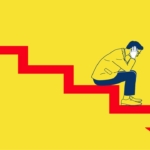Stop Worrying Yourself Out of Profits
Every time Michael thought about entering the market he said to himself “But what if I lose?” Those thoughts often paralyzed him from an action or delayed his entry so long that many opportunities simply passed before he would pick up the phone. When Michael did open a position, all he could think about were negative consequences. “My system is wrong at least half the time—what if this is one of those times?” He couldn’t sleep because his mind was racing with those “what if” thoughts. Michael suffered from a chronic “dis-ease” of the mind called worry.
Research suggests that both a biological component and a psychological component of stress impair human performance and that it is useful to consider these two components separately. The biological component is the fight-flight response, a primitive reaction that early man developed in order to survive. This physiological arousal causes people to narrow their focus and put more energy into what they are doing. It might help you run faster or fight more aggressively, but it does not help you invest more successfully.
The psychological component of stress is what Michael was doing: worrying. It involves a concern for one’s performance and its consequences. It is the expectation of failure and the negative self-evaluation that accompanies failure. Worry is probably the precursor to the fight-flight reaction. Constant worry or intense worry certainly produces physical stress and, as such, worry might be expected to only have a mild effect on performance. Research, however, shows the converse is true. Though physical stress at its extreme might result in death, worry generally has a much greater effect on human performance than its biological counter. Much of the experimental research on worry has dealt with a common problem of students—their concern about performance on an examination. Students who worry about test performance are likely to do poorly compared with students who are not concerned. The worry has nothing to do with preparation for the examination—it is simply the fear of poor performance. As a result, concerned students spend at least 25% of their conscious thought worrying about their grades on the examination rather than devoting their full effort to taking the examination. Michael, the investor who cannot sleep well because he was concerned over possible negative consequences, will perform as poorly as the worrying students. His ability to forecast price movement or select good investment opportunities does not matter. His constant worry about his performance ensures that he will not achieve optimum results.
Worry and Information Capacity
Our senses are constantly bombarded with millions of bits of information. One can only select a small portion of this information for conscious processing. Thus, people have a limited capacity for dealing with information that comes through the senses. You can test this capacity in yourself by reading the following list of numbers, closing your eyes and then recalling as many of them as you can:
78 23 81 59 44 90 37 17 4 91 16 55 98 11 84
Unless you have an elaborate strategy for organizing the numbers into groupings that you can memorize, the basis for most mnemonic techniques, you probably were not able to recall many of them. Fifteen two-digit numbers far exceed the capacity of most people.
Now imagine what other people will think of you if you don’t recall all 15 numbers. Perhaps they’ll think you are stupid or getting old or incapacitated. In addition, imagine that you will be fined $1,000 for each number that you miss. You could lose up to $15,000 if you miss them all. And what if the numbers you think you know, turn out to be wrong? You really could miss all of them!
Now, keeping all of these thoughts in your mind, try again to recall the numbers. Chances are you missed more of them, if not all of them, on the second attempt. Why? Because worry takes up precious processing capacity. When you worry and take up capacity, little remains to perform more important tasks such as investment decision-making. Worry takes away from your ability to pay attention to what is really going on in the market.
You cannot notice subtle changes in the market or respond to them if you are too preoccupied with your fantasy of “what if.” Thus, if you worry about what will happen if you make a mistake, you probably will make that mistake. By concentrating on potential mistakes, you make them happen.
Worry and Perception
All the information obtained through the senses about the world “out there” comes from a set of complex mental operations called perception. These mental processes interpret and attach meaning to the information the senses detect. For example, one might see a set of black markings on a white piece of paper and “perceive” it as a bar chart with a “head-and-shoulders bottom” or some sort of “resistance” or, to a non-technician, just meaningless lines. Perception is a filtering process, which selects information for conscious processing. It selects information from the billions of bits impinging on our sensory apparatus, so we can cope with the world. The selection process is not random, but an active process that selects information according to one’s expectations. What one sees out there depends on what one expects to see. The investor who expects to see a bull market in stocks will tend to perceive information that supports his expectations. He will “see” bullish technical patterns in his charts and ignore any evidence that might contradict the possibility of a bull market. A worry is a form of perception based on negative expectations. People who worry anticipate negative consequences. Most stressful events are stressful because of the way they are perceived. An event is just an event. It is a person’s interpretation of the event that makes it stressful. Winners, for example, have learned how to make it “O.K. to lose.” Losers, in contrast, become extremely anxious over losses and, as a result, have difficulty “letting go” of them.
A large loss, or even the potential for a large loss, may devastate the worrier. The person who dwells on the more positive aspects of the situation will view the same event as a lesson or even an opportunity. Suppose, for example, the price of soybeans drops 20 cents per bushel. Let’s look in detail at the reactions of five commodity investors to this same event.
An old man with a smile on his face had been stopped out of soybeans early in the day. He had a $3,000 loss at the time he was stopped out, but the closing price of the day would have amounted to a much larger loss. He felt good about himself for sticking to his trading plan, so he responded to the news by smiling and telling himself, “Great! You stuck to your system.”
- A soybean farmer had sold his crop two months earlier at a much higher price because he was convinced that certain big companies were manipulating the markets down. The 20-cent price drop was, for him, further proof of manipulation. “Damn them,” he said to himself as he frowned. He remained in a bad mood the rest of the day.
- An active trader was convinced soybeans were due for a major rally. He had predicted the drop during the day and had used the opportunity to acquire a substantial long position in soybeans. He had a small loss on the day, but he felt a sense of satisfaction because his plan was working well. The only thing he said to himself was, “I’m right.”
- A company president phoned his broker in a panic even though he was short in soybeans. He now had a $3,000 profit and he was concerned the market might go against him. His broker had convinced him to enter into the position and now he was afraid that he might lose his profit. “I’ll lose again! ” he thought as he called his broker to learn if he was still bearish.
- A financial columnist was long in soybeans. He had absorbed the loss because he did not enter a stop with his order. His predominant thought was that he did not stand a chance. If he entered a stop, he was sure it would be picked off by the traders on the floor. If he sold out at a large loss, it would probably be at the low price of the day. If he held onto his position, the market probably would continue to go against him. “Why me?” he thought.
Notice how the same event is a totally different experience for each of these traders. 3 traders actually lost money in the market, yet two of them had positive experiences. Two traders made profits, yet both of them were unhappy. Of course, most people are not happy about losses or sad about profits. These examples merely illustrate that profits and losses have nothing to do with experience. People create their own experiences by the way they think. Each person experiences life differently because each person’s thinking is unique.
People who generally worry a lot will worry a lot about their investments. People who worry about their investments will tend to do so constantly. In any situation that might involve a threat to an individual’s self-esteem, worriers show a marked capacity reduction. Self-esteem situations involve a threat of failure, whether it’s a failing grade on an examination or performing poorly in the market. In fact, investing may pose a tremendous threat to an individual’s self-esteem. The losing investor may not only experience financial hardship but may also feel that he has failed to prove himself to those he loves or to himself.
How to Deal with Worry
How do you manage worry? If you can discover how you worry, then a simple solution to the problem is to do something else. If the new solution doesn’t work, then again do something else. Keep changing your approach until you find something that does work. This does not necessarily mean changing your trading system. If you execute a system poorly, you will execute a new system poorly. “Changing your approach” means changing how you think, how you make decisions, and how you execute your system.
This solution is simple, but most people find it very difficult to accomplish because they are locked into certain patterns. Changing the way you think and perceive the world is not always easy. To change the way you think, you must first discover how you start the worrying process. Being objective about your own thinking is difficult while you are doing it, but much easier later when you can try two techniques to discover how you start worrying. The first exercise is to review a past, painful market experience. It is the quickest way to discover how you worry. You need only recall what happened just before the painful experience. You have no need to replay the experience itself.
Review the experience as if you are watching a movie of yourself. Sit back in a chair and feel yourself in that chair watching yourself on a movie screen. As you watch your movie, determine what started the worry experience. Was it something you saw or read? Was it something you heard or something someone said? Was it a feeling? What happened next? Did you start talking to yourself? Seeing pictures? Did your self-talk and pictures trigger the bad feelings? How did you do it?
When people worry they typically get themselves into a negative feedback loop. They talk to themselves, which produces bad feelings that results in more negative talk followed by more bad feelings and on and on. Others see images, which produce bad feelings that make the images worse, and so on. What kind of loop do you produce?
Once you discover how you start to worry and what kind of negative feedback loop you produce, figure out some ways to change it. Disrupt your loop in some way. If you say negative things to yourself, practice following those phrases with a picture of something pleasant. Try changing the quality of the voice you hear. If you say negative things to yourself, say it in the voice of some well-known cartoon character. Be creative. Do anything different until you find something that works for you. If you have trouble discovering how you worry from your memories, then a second exercise is to keep a worry diary. When you feel anxious or worried about an investment, make a note of it in your diary. Do so at the time you are worrying. Don’t put it off. Be sure to include the following information:
- What were you doing when you started to worry?
- What triggered the worry?
- Was it someone’s actions?
- A memory?
- A visual image?
- A feeling?
- How did you go about worrying?
- What kind of a loop do you set up for yourself? Is this a new or an old pattern?
Later, when the experience passes, make a note in your diary about what you actually did, and what you could have done instead? Also comment on your original diary entry. After recording your worry diary for several weeks, you can study it objectively. What kind of irrational fears do you have? How does worrying affect you as an investor? Most importantly, you can determine how you trigger an episode of worrying and how you go about worrying.
When you have a good idea of how you start to worry, select some changes you can make, such as those just suggested with the past memory technique. Become aware of when you start to worry and immediately select one of your changes. Once you discover how you go about worrying and have selected some alternative behaviors, practice using them. If you do so diligently, then the process will soon become automatic. Imagine yourself in some future situation where you would normally worry and practice some of the alternatives you have selected. Once you can feel at ease in an imaginary situation, you should be able to deal with the real situation. Investors who go through this process frequently comment, “It’s just not the same anymore. I don’t know what happened, but it’s not the same anymore.”
This article is taken from the book,” How to Control Stress To Become A More Successful Investor”, the second volume of Dr. Tharp’s 5-volume course on how to develop peak performance in the markets.
About the Author: Trading Coach Dr Van K Tharp, is widely recognized for his best-selling book Trade Your Way to Financial Freedom and his classic Peak Performance Home Study Course for traders and investors.
Key Takeaways
Howdy!
If you’re here for the first time, let’s get introduced.
VRD Nation is India’s premier stock market training institute and we (Team VRD Nation) are passionate about teaching each and every aspect of investing and trading.
If you’re here for the first time, don’t forget to check out “Free Training” section where we have tons of free videos and articles to kick start your stock market journey.
Also, we got two awesome YouTube channels where you can continue the learning process.
Must-Read Articles
Stop Worrying Yourself Out of Profits
Every time Michael thought about entering the market he said to himself “But what if I lose?” Those thoughts often paralyzed him from an action or delayed his entry so long that many opportunities simply passed before he would pick up the phone. When Michael did open a position, all he could think about were negative consequences. “My system is wrong at least half the time—what if this is one of those times?” He couldn’t sleep because his mind was racing with those “what if” thoughts. Michael suffered from a chronic “dis-ease” of the mind called worry.
Research suggests that both a biological component and a psychological component of stress impair human performance and that it is useful to consider these two components separately. The biological component is the fight-flight response, a primitive reaction that early man developed in order to survive. This physiological arousal causes people to narrow their focus and put more energy into what they are doing. It might help you run faster or fight more aggressively, but it does not help you invest more successfully.
The psychological component of stress is what Michael was doing: worrying. It involves a concern for one’s performance and its consequences. It is the expectation of failure and the negative self-evaluation that accompanies failure. Worry is probably the precursor to the fight-flight reaction. Constant worry or intense worry certainly produces physical stress and, as such, worry might be expected to only have a mild effect on performance. Research, however, shows the converse is true. Though physical stress at its extreme might result in death, worry generally has a much greater effect on human performance than its biological counter. Much of the experimental research on worry has dealt with a common problem of students—their concern about performance on an examination. Students who worry about test performance are likely to do poorly compared with students who are not concerned. The worry has nothing to do with preparation for the examination—it is simply the fear of poor performance. As a result, concerned students spend at least 25% of their conscious thought worrying about their grades on the examination rather than devoting their full effort to taking the examination. Michael, the investor who cannot sleep well because he was concerned over possible negative consequences, will perform as poorly as the worrying students. His ability to forecast price movement or select good investment opportunities does not matter. His constant worry about his performance ensures that he will not achieve optimum results.
Worry and Information Capacity
Our senses are constantly bombarded with millions of bits of information. One can only select a small portion of this information for conscious processing. Thus, people have a limited capacity for dealing with information that comes through the senses. You can test this capacity in yourself by reading the following list of numbers, closing your eyes and then recalling as many of them as you can:
78 23 81 59 44 90 37 17 4 91 16 55 98 11 84
Unless you have an elaborate strategy for organizing the numbers into groupings that you can memorize, the basis for most mnemonic techniques, you probably were not able to recall many of them. Fifteen two-digit numbers far exceed the capacity of most people.
Now imagine what other people will think of you if you don’t recall all 15 numbers. Perhaps they’ll think you are stupid or getting old or incapacitated. In addition, imagine that you will be fined $1,000 for each number that you miss. You could lose up to $15,000 if you miss them all. And what if the numbers you think you know, turn out to be wrong? You really could miss all of them!
Now, keeping all of these thoughts in your mind, try again to recall the numbers. Chances are you missed more of them, if not all of them, on the second attempt. Why? Because worry takes up precious processing capacity. When you worry and take up capacity, little remains to perform more important tasks such as investment decision-making. Worry takes away from your ability to pay attention to what is really going on in the market.
You cannot notice subtle changes in the market or respond to them if you are too preoccupied with your fantasy of “what if.” Thus, if you worry about what will happen if you make a mistake, you probably will make that mistake. By concentrating on potential mistakes, you make them happen.
Worry and Perception
All the information obtained through the senses about the world “out there” comes from a set of complex mental operations called perception. These mental processes interpret and attach meaning to the information the senses detect. For example, one might see a set of black markings on a white piece of paper and “perceive” it as a bar chart with a “head-and-shoulders bottom” or some sort of “resistance” or, to a non-technician, just meaningless lines. Perception is a filtering process, which selects information for conscious processing. It selects information from the billions of bits impinging on our sensory apparatus, so we can cope with the world. The selection process is not random, but an active process that selects information according to one’s expectations. What one sees out there depends on what one expects to see. The investor who expects to see a bull market in stocks will tend to perceive information that supports his expectations. He will “see” bullish technical patterns in his charts and ignore any evidence that might contradict the possibility of a bull market. A worry is a form of perception based on negative expectations. People who worry anticipate negative consequences. Most stressful events are stressful because of the way they are perceived. An event is just an event. It is a person’s interpretation of the event that makes it stressful. Winners, for example, have learned how to make it “O.K. to lose.” Losers, in contrast, become extremely anxious over losses and, as a result, have difficulty “letting go” of them.
A large loss, or even the potential for a large loss, may devastate the worrier. The person who dwells on the more positive aspects of the situation will view the same event as a lesson or even an opportunity. Suppose, for example, the price of soybeans drops 20 cents per bushel. Let’s look in detail at the reactions of five commodity investors to this same event.
An old man with a smile on his face had been stopped out of soybeans early in the day. He had a $3,000 loss at the time he was stopped out, but the closing price of the day would have amounted to a much larger loss. He felt good about himself for sticking to his trading plan, so he responded to the news by smiling and telling himself, “Great! You stuck to your system.”
- A soybean farmer had sold his crop two months earlier at a much higher price because he was convinced that certain big companies were manipulating the markets down. The 20-cent price drop was, for him, further proof of manipulation. “Damn them,” he said to himself as he frowned. He remained in a bad mood the rest of the day.
- An active trader was convinced soybeans were due for a major rally. He had predicted the drop during the day and had used the opportunity to acquire a substantial long position in soybeans. He had a small loss on the day, but he felt a sense of satisfaction because his plan was working well. The only thing he said to himself was, “I’m right.”
- A company president phoned his broker in a panic even though he was short in soybeans. He now had a $3,000 profit and he was concerned the market might go against him. His broker had convinced him to enter into the position and now he was afraid that he might lose his profit. “I’ll lose again! ” he thought as he called his broker to learn if he was still bearish.
- A financial columnist was long in soybeans. He had absorbed the loss because he did not enter a stop with his order. His predominant thought was that he did not stand a chance. If he entered a stop, he was sure it would be picked off by the traders on the floor. If he sold out at a large loss, it would probably be at the low price of the day. If he held onto his position, the market probably would continue to go against him. “Why me?” he thought.
Notice how the same event is a totally different experience for each of these traders. 3 traders actually lost money in the market, yet two of them had positive experiences. Two traders made profits, yet both of them were unhappy. Of course, most people are not happy about losses or sad about profits. These examples merely illustrate that profits and losses have nothing to do with experience. People create their own experiences by the way they think. Each person experiences life differently because each person’s thinking is unique.
People who generally worry a lot will worry a lot about their investments. People who worry about their investments will tend to do so constantly. In any situation that might involve a threat to an individual’s self-esteem, worriers show a marked capacity reduction. Self-esteem situations involve a threat of failure, whether it’s a failing grade on an examination or performing poorly in the market. In fact, investing may pose a tremendous threat to an individual’s self-esteem. The losing investor may not only experience financial hardship but may also feel that he has failed to prove himself to those he loves or to himself.
How to Deal with Worry
How do you manage worry? If you can discover how you worry, then a simple solution to the problem is to do something else. If the new solution doesn’t work, then again do something else. Keep changing your approach until you find something that does work. This does not necessarily mean changing your trading system. If you execute a system poorly, you will execute a new system poorly. “Changing your approach” means changing how you think, how you make decisions, and how you execute your system.
This solution is simple, but most people find it very difficult to accomplish because they are locked into certain patterns. Changing the way you think and perceive the world is not always easy. To change the way you think, you must first discover how you start the worrying process. Being objective about your own thinking is difficult while you are doing it, but much easier later when you can try two techniques to discover how you start worrying. The first exercise is to review a past, painful market experience. It is the quickest way to discover how you worry. You need only recall what happened just before the painful experience. You have no need to replay the experience itself.
Review the experience as if you are watching a movie of yourself. Sit back in a chair and feel yourself in that chair watching yourself on a movie screen. As you watch your movie, determine what started the worry experience. Was it something you saw or read? Was it something you heard or something someone said? Was it a feeling? What happened next? Did you start talking to yourself? Seeing pictures? Did your self-talk and pictures trigger the bad feelings? How did you do it?
When people worry they typically get themselves into a negative feedback loop. They talk to themselves, which produces bad feelings that results in more negative talk followed by more bad feelings and on and on. Others see images, which produce bad feelings that make the images worse, and so on. What kind of loop do you produce?
Once you discover how you start to worry and what kind of negative feedback loop you produce, figure out some ways to change it. Disrupt your loop in some way. If you say negative things to yourself, practice following those phrases with a picture of something pleasant. Try changing the quality of the voice you hear. If you say negative things to yourself, say it in the voice of some well-known cartoon character. Be creative. Do anything different until you find something that works for you. If you have trouble discovering how you worry from your memories, then a second exercise is to keep a worry diary. When you feel anxious or worried about an investment, make a note of it in your diary. Do so at the time you are worrying. Don’t put it off. Be sure to include the following information:
- What were you doing when you started to worry?
- What triggered the worry?
- Was it someone’s actions?
- A memory?
- A visual image?
- A feeling?
- How did you go about worrying?
- What kind of a loop do you set up for yourself? Is this a new or an old pattern?
Later, when the experience passes, make a note in your diary about what you actually did, and what you could have done instead? Also comment on your original diary entry. After recording your worry diary for several weeks, you can study it objectively. What kind of irrational fears do you have? How does worrying affect you as an investor? Most importantly, you can determine how you trigger an episode of worrying and how you go about worrying.
When you have a good idea of how you start to worry, select some changes you can make, such as those just suggested with the past memory technique. Become aware of when you start to worry and immediately select one of your changes. Once you discover how you go about worrying and have selected some alternative behaviors, practice using them. If you do so diligently, then the process will soon become automatic. Imagine yourself in some future situation where you would normally worry and practice some of the alternatives you have selected. Once you can feel at ease in an imaginary situation, you should be able to deal with the real situation. Investors who go through this process frequently comment, “It’s just not the same anymore. I don’t know what happened, but it’s not the same anymore.”
This article is taken from the book,” How to Control Stress To Become A More Successful Investor”, the second volume of Dr. Tharp’s 5-volume course on how to develop peak performance in the markets.
About the Author: Trading Coach Dr Van K Tharp, is widely recognized for his best-selling book Trade Your Way to Financial Freedom and his classic Peak Performance Home Study Course for traders and investors.




















Leave A Comment